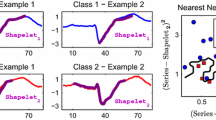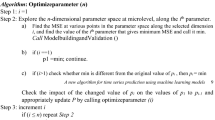Abstract
The regression-by-discretization approach allows the use of classification algorithm in a regression task. It works as a pre-processing step in which the numeric target value is discretized into a set of intervals. We had applied this approach to the Hidden Markov Model for Regression (HMMR) which was successfully compared to the Naive Bayes for Regression and two traditional forecasting methods, Box-Jenkins and Winters. In this work, to further improve these results, we apply three discretization methods to HMMR using ten time series data sets. The experimental results showed that one of the discretization methods improved the results in most of the data sets, although each method improved the results in at least one data set. Therefore, it would be better to have a search algorithm to automatically find the optimal number and width of the intervals.
Preview
Unable to display preview. Download preview PDF.
Similar content being viewed by others
References
Box, G.E.P., Jenkins, G.M., Reinsel, G.C.: Time Series Analysis: Forecasting & Control. Prentice-Hall, Englewood Cliffs (1994)
Dietterich, T.G.: The Divide-and-Conquer Manifesto. In: Proceedings of the Eleventh International Conference on Algorithmic Learning Theory, pp. 13–26 (2000)
Domingos, P., Pazzani, M.: On the Optimality of the Simple Bayesian Classifier under Zero-One Loss. Machine Learning 29(2/3), 103–130 (1997)
Frank, E., Trigg, L., Holmes, G., Witten, I.H.: Naive Bayes for Regression. Machine Learning 41(1), 5–25 (1999)
Friedman, N., Goldszmidt, M., Lee, T.J.: Bayesian network classification with continuous attributes: Getting the best of both discretization and parametric fitting. In: 15th Inter. Conf. on Machine Learning (ICML), pp. 179–187 (1998)
Ghahramani, Z.: Learning Dynamic Bayesian Networks. In: Giles, C.L., Gori, M. (eds.) Adaptive Processing of Sequences and Data Structures. LNCS (LNAI), pp. 168–197. Springer, Berlin (1998)
Montgomery, D.C., Johnson, L.A., Gardiner, J.S.: Forecasting and Time Series Analysis. McGraw-Hill Companies, New York (1990)
Roweis, S., Ghahramani, Z.: A Unifying Review of Linear Gaussian Models. Neural Computation 11(2), 305–345 (1999)
Russell, S., Norvig, P.: Artificial Intelligence: A Modern Approach, 2nd edn. Prentice Hall, Englewood Cliffs (2002)
Teixeira, M.A., Revoredo, K., Zaverucha, G.: Hidden Markov Model for Regression in Electric Load Forecasting. In: Proceedings of the ICANN/ICONIP 2003, Turkey, vol. 1, pp. 374–377 (2003)
Teixeira, M.A., Zaverucha, G.: Fuzzy Bayes and Fuzzy Markov Predictors. Journal of Intelligent and Fuzzy Systems 13(2-4), 155–165 (2003)
Teixeira, M.A., Zaverucha, G.: Fuzzy Markov Predictor in Multi-Step Electric Load Forecasting. In: The Proceedings of the IEEE/INSS International Joint Conference on Neural Networks (IJCNN 2003), Portland, Oregon, vol. 1, pp.3065–3070 (2003)
Torgo, L., Gama, J.: Regression Using Classification Algorithms. Intelligent Data Analysis 1, 275–292 (1997)
Weiss, S., Indurkhya, N.: Rule-base Regression. Proceedings of the 13th Internationa Joing Conference on Artificial Intelligence, 1072–1078 (1993)
Weiss, S., Indurkhya, N.: Rule-base Machine Learning Methods for Functional Prediction. Journal of Artificial Intelligence Research (JAIR) 3, 383–403 (1995)
Urban Hjorth, J.S.: Computer Intensive Statistical Methods. In: Validation Model Selection and Bootstrap, Chapman & Hall, Sydney (1994)
Keogh, E., Kasetty, S.: On the Need for Time Series Data Mining Benchmarks: A Survey and Empirical Demonstration. Data Mining and Knowledge Discovery 7, 349–371 (2003)
http://www-psych.stanford.edu/%7Eandreas/Time-Series/SantaFe
ftp://ftp.esat.kuleuven.ac.be/pub/sista/suykens/workshop/datacomp.dat
Author information
Authors and Affiliations
Editor information
Editors and Affiliations
Rights and permissions
Copyright information
© 2004 Springer-Verlag Berlin Heidelberg
About this paper
Cite this paper
Revoredo, K., Zaverucha, G. (2004). Search-Based Class Discretization for Hidden Markov Model for Regression. In: Bazzan, A.L.C., Labidi, S. (eds) Advances in Artificial Intelligence – SBIA 2004. SBIA 2004. Lecture Notes in Computer Science(), vol 3171. Springer, Berlin, Heidelberg. https://doi.org/10.1007/978-3-540-28645-5_32
Download citation
DOI: https://doi.org/10.1007/978-3-540-28645-5_32
Publisher Name: Springer, Berlin, Heidelberg
Print ISBN: 978-3-540-23237-7
Online ISBN: 978-3-540-28645-5
eBook Packages: Springer Book Archive




